The Economics and Statistics Division maintains archives of previous publications for accountability purposes, but makes no updates to keep these documents current with the latest data revisions from Statistics Canada. As a result, information in older documents may not be accurate. Please exercise caution when referring to older documents. For the latest information and historical data, please contact the individual listed to the right.
<--- Return to Archive
For additional information relating to this article, please contact:
November 25, 2022GOVERNMENT EXPENDITURE BY FUNCTION, 2021 Statistics Canada has published details from Consolidated Government Finance Statistics for 2021 including consolidated results for provincial-territorial and local governments by nine functional areas of expenditure: health care, education, social protection, general public service (which includes debt payments), economic affairs (which includes transportation), public order/safety, environmental protection (which includes wastewater and solid waste), housing/community amenities (which includes water services) and recreation/culture.
Details on defence spending are provided only at the Federal level. Annual data correspond to the end of the fiscal year closest to December 31. For example, data for the fiscal year ending on March 31, 2022 (fiscal year 2021-22) are reported as the 2021 reference year. Per capita expenditures are calculated using the population as of July 1 during the fiscal year; for fiscal year 2021-22, per capita expenditures are calculated using the population as of July 1, 2021.
These data are based on the international government financial statistical standard and, as such, may differ in their presentation from similar concepts reported in Public Accounts and other financial statements. Statistics Canada's data allows for comparability across jurisdictions.
Total per capita expenditures by provincial-local government function added up to $15,371 in Nova Scotia, $1,025 per capita below the provincial-local government average in 2021 ($16,396). Nova Scotia reported the lowest per capita expenditure among provinces - just below expenditures in British Columbia, Ontario and New Brunswick. Saskatchewan reported the highest expenditures per capita, reflecting unusually large crop insurance payments during a drought.
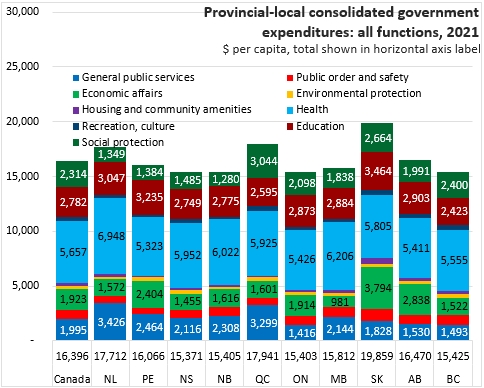

In the last year, Nova Scotia's per capita consolidated expenditures on provincial-local government functions increased by $832 per capita or 5.7%. National expenditures increased by $807 per capita or 5.2%. The fastest growth was in Saskatchewan (+18.6% or +$3,116 per capita) while New Brunswick (+1.3% or +$197 per capita) and Manitoba (+1.3% or +$206 per capita) reported the slowest growth in per capita spending.
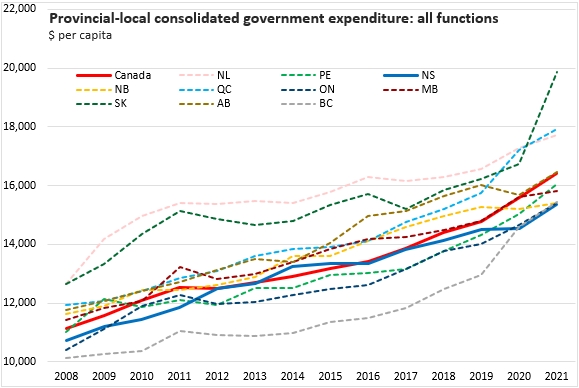
Health care makes up the largest per capita expenditure function in every provincial-local government. Nova Scotia's health expenditures of $5,952 per capita were above the national average of $5,657 per capita. Hospitals and outpatient services make up the bulk of health care spending. Nova Scotia's per capita expenditures were higher than average for hospitals ($4,370 per capita) and public health ($526 per capita) but lower for outpatient services ($640 per capita). The highest health expenditures were reported in Newfoundland and Labrador while the lowest were reported in Prince Edward Island.

Note: n.e.c. refers to expenditures "not elsewhere classified".
Although health care expenditures have been increasing for many years, health care expenditures grew rapidly across most provinces in 2020 before growth slowed again in 2021. National per capita health expenditures increased by $213 per capita or 3.9% from 2020 to 2021. In Nova Scotia, health care expenditures increased by $142 per capita or 2.4%. The fastest growth in health expenditures were reported in Prince Edward Island (+6.5% or +$326 per capita), followed by British Columbia (+6.2% or +$325 per capita) and Saskatchewan (+6.2% or +$338 per capita). Alberta (+0.1% or +$4 per capita) reported the least growth in health expenditures.
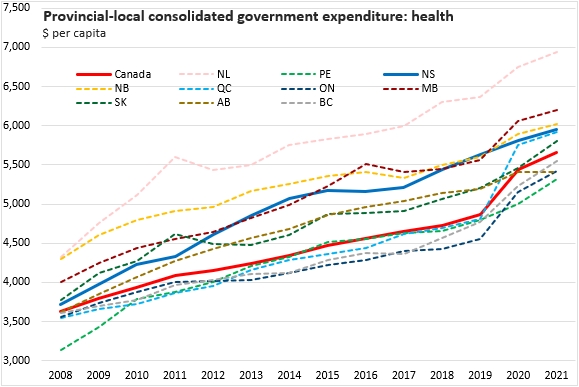
Education is the second largest functional expenditure made by provincial-local governments. Nova Scotia's education spending of $2,749 per capita was just below the national average among provincial-local governments ($2,782 per capita). Nova Scotia's spending on universities ($931 per capita) was the highest among provinces. Nova Scotia's expenditures for primary/secondary education ($1,572 per capita) and colleges ($227 per capita) were below the national per capita averages. Per capita education spending was highest in Saskatchewan and lowest in British Columbia.
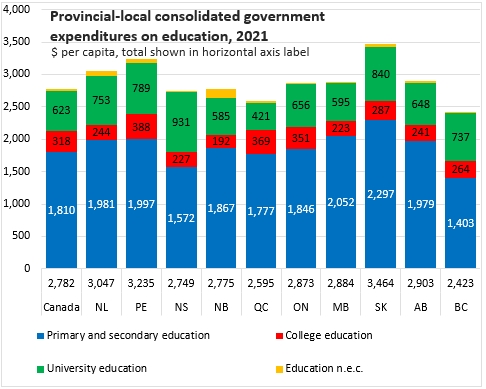
Nova Scotia's per capita education spending declined by 2.5% or $70 per capita from 2020 to 2021 - the only province to report a decline. National education expenditures increased by 3.4% ($90 per capita) with the fastest gains in Manitoba (+8.4% or +$223 per capita).
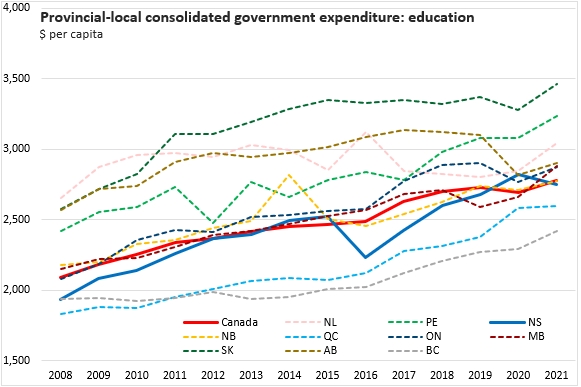
Provincial-local government consolidated expenditures on social protection amounted to $1,485 per capita in Nova Scotia - lower than the national average of $2,314 per capita. Expenditures on social protection exhibit a wide variation across Canada, with over $1,700 per capita difference from the lowest spending provincial-local government (New Brunswick) to the highest (Quebec). Some of this variation is explained by markedly different service levels across provinces. For example, Saskatchewan's higher payments for sickness and disability are attributable to benefits provided under that province's public auto insurance program.
Sickness/disability payments make up the largest portion of social protection expenditures in most jurisdictions, followed in some by children/family services and in others by expenditures to address social exclusion (including funding for low-income earners, refugees and homeless persons).
Nova Scotia's expenditures on sickness/disability ($566 per capita) and family/children ($225 per capita) were below the national averages. Nova Scotia's per capita expenditures on social exclusion were $474 per capita while expenditures on housing were $216 per capita - both above their respective national averages.
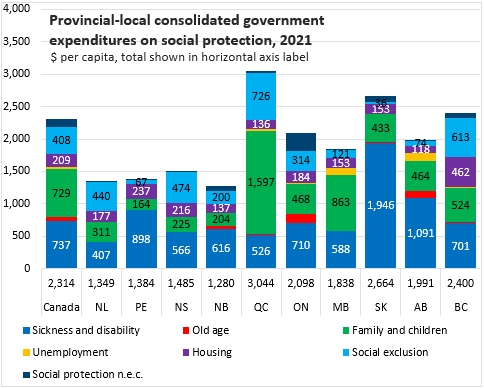
Consolidated provincial-local expenditures on social protection increased by 11.2% (+$150 per capita) in Nova Scotia from 2020 to 2021. National expenditures increased by 6.4% (+$140 per capita) with the largest gain in Quebec (+24.9% or +$607 per capita) and the largest declines in Manitoba (-8.0% or -$160 per capita) and British Columbia (-7.6% or -$197 per capita).
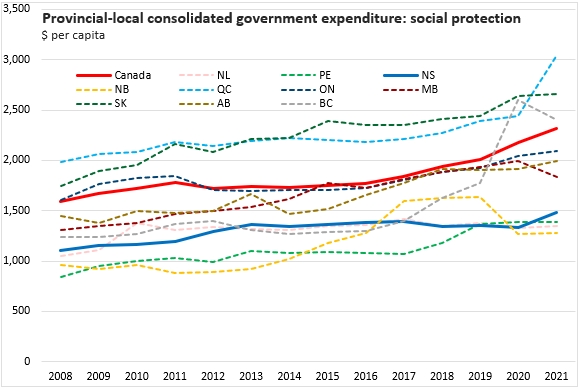
General public service expenditures (consolidated provincial-local) were $2,116 per capita in Nova Scotia, including $815 per capita in public debt transactions, $687 per capita in general provincial-local government services and $227 per capita in executive/legislative/financial/fiscal affairs. Nova Scotia's general public service expenditures are below the national per capita average. The highest expenditures on general public services were in Newfoundland and Labrador as well as Quebec. The lowest general public service expenditures were in Alberta, British Columbia and Ontario (followed by Nova Scotia).
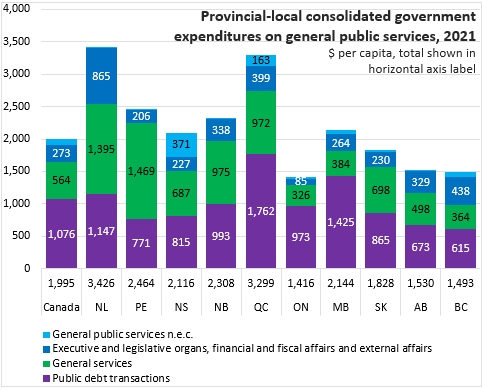
In the last year of data, Nova Scotia's consolidated provincial-local expenditures on general public services increased by 21.8% or +$379 per capita, the largest gain among the provinces (rebounding from the largest contraction in 2020).
Across Canada, provincial-local consolidated expenditures on general public services were up 3.6% or +$70 per capita. The largest decline was reported in New Brunswick (-5.6% or -$138 per capita).
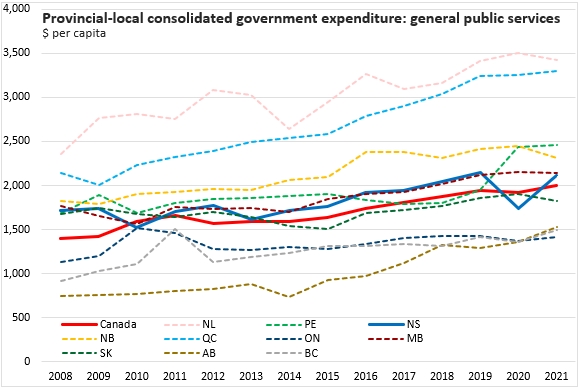
The economic affairs functional category includes expenditures in a wide range of activities. Transportation is the largest provincial-local exepnditure on economic affairs across Canada, but it is not the largest expenditure in Alberta (fuel and energy) and Saskatchewan (agriculture, forestry, fishing, hunting) and Nova Scotia (general economic/commercial/labour affairs).
Overall per capita spending on economic affairs in Nova Scotia was $1,455 - below the national average of $1,923. The highest expenditures on economic affairs were in Saskatchewan and Alberta, with high crop insurance payments as well as large expenditures on the economic affairs of fuel and energy. The lowest spending on economic affairs was reported in Manitoba.
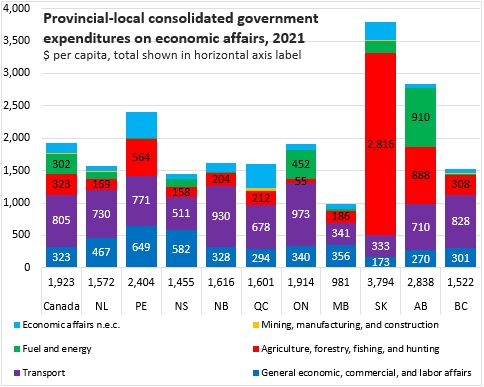
From 2020 to 2021, Nova Scotia's consolidated provincial-local expenditures on economic affairs (including transportation) grew by 17.0% or +$211 per capita. National expenditures grew by 15.3% or +$255 per capita. Growth was fastest in Saskatchewan (+184.6% or +$2,461 per capita) while only Quebec (-2.5% or -$42 per capita) reported a decline.
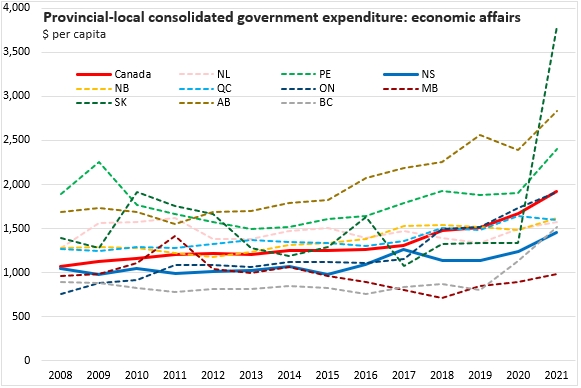
Expenditures on public order and safety were $798 per capita in Canada and $747 per capita in Nova Scotia. Police services made up the largest part of these expenditures, followed by law courts and fire protection services. The highest expenditures on public order and safety were reported in Manitoba and Saskatchewan (where prison spending was notably higher). The lowest expenditures on public safety were in Prince Edward Island and Quebec. Nova Scotia's expenditures on public safety were below the national averages for police services, fire protection and prisons, but higher for law courts.

Nova Scotia's consolidated provincial-local expenditures on public order and safety fell by 1.1% or -$8 per capita from 2020 to 2021, the second consecutive year of decline. Across Canada, these expenditures were up 3.5% or +$27 per capita. The largest decline was reported in Quebec (-1.3% or -$8 per capita) while British Columbia (+10.8% or +$88 per capita) reported the largest increase.
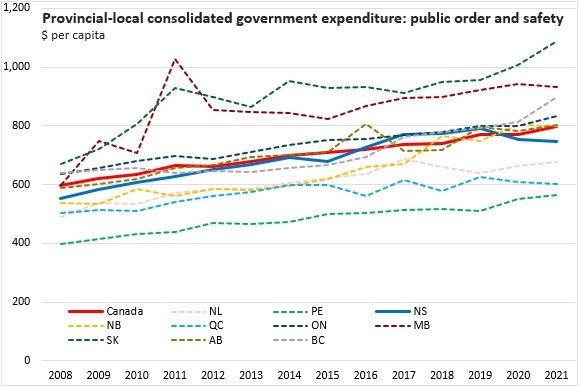
Spending on recreation and cultural services was $369 per capita across Canada and $335 per capita in Nova Scotia. Recreation and culture spending was higher in British Columbia, which has a larger expenditure on broadcasting/publishing services. Prince Edward Island had the lowest spending on recreation and cultural services.

National consolidated provincial-local spending on recreation and culture was down 1.8% or +$7 per capita from 2020 to 2021. The largest gain was reported in Ontario (+6.1% or +$18 per capita) while Manitoba reported the largest decline (-11.8% or -$31 per capita). Nova Scotia's expenditures on recreation and culture increased by 5.4% or +$17 per capita.
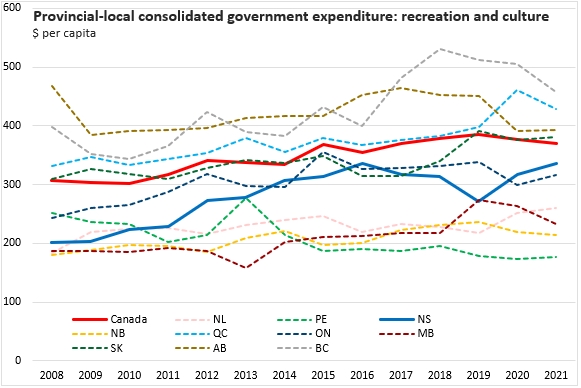
National consolidated provincial-local spending on environmental protection was $322 per capita in 2021. Nova Scotia's expenditures on environmental protection were $330 per capita. Waste management and waste water management typically make up the largest portions of national expenditures on environmental protection. Nova Scotia and Prince Edward Island reported the highest expenditures on waste management while British Columbia and Saskatchewan spent the most on waste water management. Other environmental protection expenditures (n.e.c.) were higher in Manitoba, Saskatchewan and Nova Scotia; these other expenditures include administration, enforcement and data dissemination.
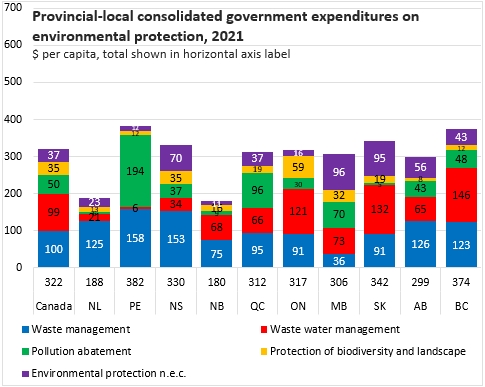
There was a large increase in consolidated provincial-local expenditures on environmental protection reported in Nova Scotia (+13.6% or +$40 per capita) while Manitoba reported a substantial decline (-11.3% or -$39 per capita).
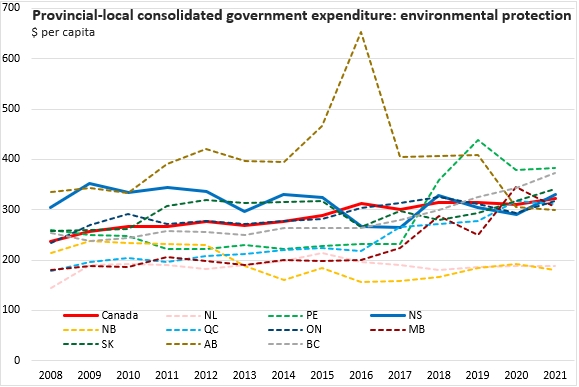
Consolidated provincial-local spending on housing and community amenities amounted to $236 per capita nationally and $202 per capita in Nova Scotia. Provision of water supply makes up the largest part of housing/community amenity spending in all provinces. Nova Scotia made the highest expenditures on street lighting among provinces ($40 per capita).

From 2020 to 2021, Nova Scotia reported the largest decrease in consolidated provincial-local expenditures per capita on housing and community amenities (-12.0% or -$27 per capita), contracting after growth in 2019 and 2020. National expenditures on housing and community amenities were up 3.3% or +$8 per capita. New Brunswick reported the largest growth in spending on housing and community amenities (+16.6% or +$30 per capita).
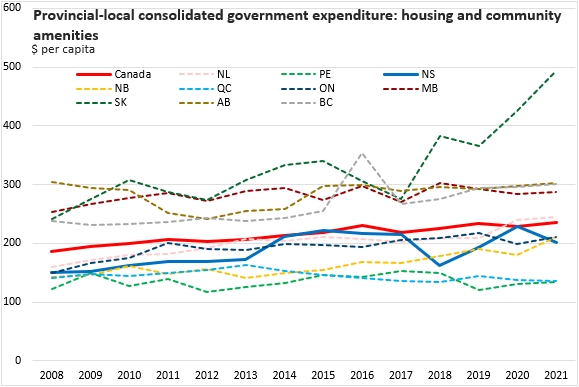
Statistics Canada. Table 10-10-0005-01 Canadian Classification of Functions of Government (CCOFOG) by consolidated government component (x 1,000,000), Table 17-10-0005-01 Population estimates on July 1st, by age and sex
<--- Return to Archive